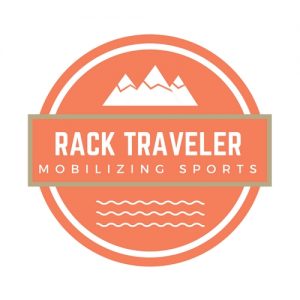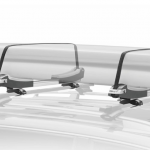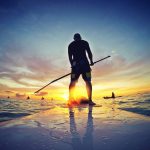How to Ride a Mountain Bike for Beginners

Beginning any new endeavor could be a little scary for any of us. Especially if we’re a little older and trying new things is something we used to do. No matter the age or the experience in outdoor sports, if their is anything we have in common we know damn well mountain biking can be a whole lot of fun.
Whether your in a group or alone with your bike, fully focused and far from the real world there aren’t many experiences better than this.
This is why we decide to share some tips and techniques for how to ride a mountain bike for beginners. At Rack Traveler it’s a must to share tips and techniques we’ve learned over the years with our readers.
Before you go on your next trail you should take a look at some of the information we shared below. With so much information on the web that could overwhelm the best of us, we knew it would be a good idea to put some of our best tips together to help a fellow mountain biker.
If you’re ready to learn more about this passion of ours and escape the daily routines of the world, you have to get out there! Get off the couch and off your behind and grab a bike, helmet and of course a rack to transport your bike safely and securely. We hope to and inspire, teach and give you everything you need to know on how to ride a mountain bike for beginners.
Getting Started
No one starts out as a pro. You can start out light, maybe riding an hour or two to get the juices flowing. You can gradually work your way up to an hour or two if it’s too much at once.
Maybe do 30 minutes for a week and progress weekly in increments of 30 minutes. However you choose and think is best for you go for it.
As long as your out their trying and working to where you want to be is whats important. Try sticking to the lower gears when you begin to get adjusted. The last thing you want to do is go over board and possibly hurt yourself.
Mountain biking will work out your entire body. Believe your arms, legs , back and all kinds a muscles will burn. Now don’t get discouraged, because of a little pain. We want pain, thats how you know you’re trying to improve.
The more you ride the better your stamina will get and the more you can challenge yourself. You can mix long rides at a steady pace and when you think you’re ready for it throw in some short sprints.
As you increase your endurance challenge yourself more. You’ll start to see your body transforming into the shape you always wanted. Overtime you will start to notice you can actually do this. You’ll then share this how to ride a mountain bike for beginners guide with a friend or two, right?
Oh yeah, don’t forget to stretch daily!
back to menu ↑Checking Your Bike
Without a good bike you won’t enjoy mountain biking. Be sure the bike works for you and that you’ll be comfortable riding it.
Make sure the saddle isn’t too high. High saddles can increase the chances of chafing and cause less balance. Don’t go putting the saddle too low either. If the saddle is too low it can cause knee pain and wear your muscles out quicker.
The best way to find a good balance is by sitting in the saddle, rotating the peddle until it’s parallel with the ground and making sure your leg is straight. Make sure that you’re not rocking back-in forth either. If you are, lower your saddle. You just want to make sure your well balanced, not too high not too low.
You should build a habit of always checking your bike before you ride. This can ensure you don’t get stuck on a trail and yo don’t hurt yourself. You should always check the tire pressure, wheels, brakes and head gear. If you feel uncomfortable about any of these get to a local bike shop for a tune up.
Check list:
- Your brakes should respond quickly and snap back
- Your head gear should be stable and secure
- Wheels should spin without side movement
Clothing Required
To start off you don’t need to look like team U.S.A., although it feels pretty cool to be in full gear. Especially if your on a high budget or you just want to see if it’s something for you.
You can start off by purchasing some padded shorts, head gear and some gloves. You may think the padded shorts make you look weird, but they will make your ride way more comfortable. Once you feel mountain biking is something you want to continue to pursue you can step your gear up to the next level.
back to menu ↑Prevent Chafing
If you ever rode a bike, even as a kid. I’m sure you’ve experienced chafing at least once in your life. It’s the most annoying and uncomfortable feeling in the world, especially after a great ride on the trails.
There are ways to prevent this from happening. The best way to prevent it and I know many cyclist who use it is purchasing Chamois Butt’r. (View Price on Amazon)
You can also purchase vaseline from your local supermarket and rub it on the location on your body you feel is best. Get some. Be sure to use it before you ride to avoid the awkward walk and to make sure it does not discourage you for future rides.
back to menu ↑Sunglasses Are a Must
Remember, mountain biking takes place outdoors, so you’ll get your fair share of wind and debris attacking you it seems like. If you’re in an area with trees you might have a branch or two slapping you in the face. So it’s best to keep your eyes protected, especially at increased speeds.
You can always visit your local optometrist for prescription sports glasses if necessary.
back to menu ↑Head Gear
Stable head gear is important incase you fall, which I have seen more than once. You want to avoid the helmet from wobbling or fitting loose. Your helmet can save your lifee incase of a really bad fall. It doesn’t happen often, but I would never risk it.
It’s better to play it safe and make sure it fits secure on our head to avoid any accidents from happening. The chinstraps should also fit securely. You don’t want them too high to where there choking you, but tight enough to where the helmet won’ move around on a bumpy ride.
Note: Try to find a CSA or equivalent sticker on the inside of the helmet.
back to menu ↑Additional Items
Its always a good idea to carry some drinks and snacks with you. You want to stay hydrated with water or maybe Gatorade. I personally always like to bring some high protein energy bars with me when I ride.
You should always carry an extra inner tube, pump and tyre levers. I usually use a weather proof bag in case I get hit by a sudden storm. Whatever you like to drink or eat just make sure you stay hydrated and energized.
back to menu ↑Braking
Braking is of course important. You need to learn when or how much to pump the brakes, especially going down hill. When you’re going down hill the front tire is carrying more weight. A good thing to know is that the more weight the tire has, the more braking power it will have. Front brakes are more helpful in this situation, because they will prevent you from skidding and keep you in control.
Just make sure you don’t use too much front brake or else you’ll go flying forward. Use the rear brake as well.
When going down hill the rear brakes are also useful. When you shift your weight to the back of the bike use you rear brake. Utilizing both brakes will will give you greater control over the bike.
Overtime you will learn how much weight and brake to use when shifting back and forth. Once you get this down you will find greater control and grow your confidence. Ask other rider and tips or join an MTB group.
back to menu ↑Hands on the Bars
Make sure you keep you hands on the handle bars!
Most new riders have the tendency of keeping their hands over the brakes incase anything happens. Its understandable that your nerves maybe running a little high and you want to protect yourself in an unexpected situation.
The problem with doing this is when you hit a drop and your hands clinch to hold on, they press the brakes and guess who goes flying? I’ll let you answer that.
So stay relaxed and keep your hands on the handle bars. Don’t squeeze the handle bars to tight either just relax and keep your hands in a steady grip. If necessary your fingers are more than quick enough to get to the brake on time.
back to menu ↑Tire Pressure
A very important tip for new riders is to not run your tire pressure too high. Harder tires with more psi will reduce traction and handling. If someone tells you the harder the tire the faster you will go, just agree with them and keep riding.
Now don’t keep the tire pressure too low either, you don’t want your rim getting damaged from rocks or when your jumping. You can feel comfortable running your tires between 35 – 45 psi.
back to menu ↑Technique
An important factor in MTB is just staying relaxed. You have to be comfortable moving on the bike. Your body will need to move to have control and keep balance. Don’t be afraid and let nature guide your movements.
back to menu ↑What About Trails
Most local bike shops have knowledge about MTB groups or trails. You can even find maps of sanctioned trails that will provide ou with important information about distances, difficulty and access.
Trails are usually ranked to notify the riders by either colors or labels. Some of the more common rankings are green, blue and black. You may also see rankings labeled as Beginner, Intermidiate or Expert. Beginner, intermediate and Advanced/Expert or sometimes green, blue and black. Make sure you ask around to check where the up and down trails are to avoid having to push your bike up a downhill. (FYI not fun)
back to menu ↑Coasting
On flat ground you should keep your pedals going at a steady pace. You want to keep your pedals level to avoid catching any rocks or trees. You can either stand or sit while coasting, thats up to you. Don’t pay attention to whats beneath you, focus on what’s ahead and prepare yourself for it.
back to menu ↑Down Hill
Its very important you stand on your pedals on going down hill. You want to stand, but keep your legs bent like springs ready to absorb and drops or bumps. Position the rest of your body in the same way. Low and angled in a way that will keep you in control for maximum absorption.
Your pedals should be level and your heels down allowing your body to apply force to them. This will help your legs absorb anything bumps that might come your way. It will also assist when braking protecting you from falling forward.
Try to remain focused. Going down hill requires your concentration and focus to safely reach the bottom. You have to pay attention to all the details. This includes every groove, rock, root, bump and hole.
back to menu ↑Up Hill
Before you hit the up hill battle, put your bike into a lower gear so you don’t burn yourself out. We recommend pedaling at a steady pace and remaining seated.
If you stand and pedal hard you can lose traction. This is not good, because you need traction when going up hills. To increase your traction keep your weight shifted towards the back.
For increased steering put your weight towards the front, while at the same time staying seated with your shoulders low and forward pulling down and back on the handle bars.
back to menu ↑Corners
Maximizing speed control is very important. Best practice for hitting corners is braking before the corner, getting to a good speed and rolling through.
Try to keep your weight over your tires for best grip. It might sound difficult as a beginner, but keep your knees bent and open, leaning the bike as best you can. For added traction you can drop your outside foot.
Rolling over small obstacles
Your bike is designed to roll over obstacles like rocks and roots, helped by its fat tires and suspension. When you are coming to an obstacle, look ahead to it, then look on to your exit point – try not to look at the obstacle as you ride through it.
back to menu ↑Should you drink coffee?
I think it’s fair to say that most of he world starts off their morning with a cup of Joe. When I started I always drank coffee before I went out for a ride in the mornings. I don’t do it anymore. I just feel awake and energized when I go on my road rides.
Besides feeling awake, I don’t think elevated caffeine levels are helpful for MTB. You want to stay focused and have your mind and body functioning clearly. Once you get the hang of things you should try to lay off the coffee.
1. Bike Racks:
- Best Bike Hitch Racks
- Best Bike Roof Racks
- Best Spare Tire Bike Racks
- Best Trunk Bicycle Racks
- Best Bike Truck Racks
2. Kayak Racks:
3. Cargo Carriers:
4. SUP and Surfboard Racks:
5. Ski and Snowboard Racks:








